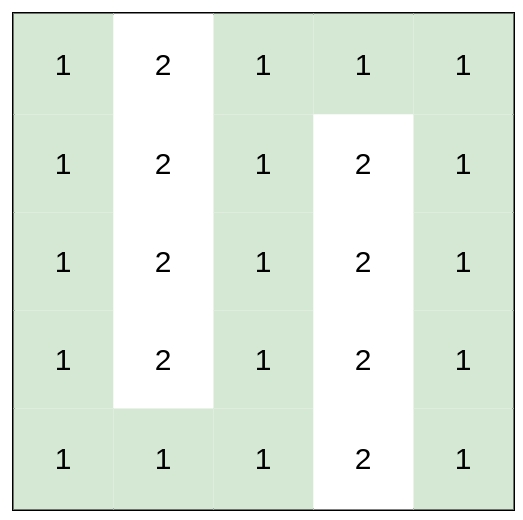1631 Path With Minimum Effort
You are a hiker preparing for an upcoming hike. You are given heights, a 2D array of size rows x columns, where heights[row][col] represents the height of cell (row, col). You are situated in the top-left cell, (0, 0), and you hope to travel to the bottom-right cell, (rows-1, columns-1) (i.e., 0-indexed). You can move up, down, left, or right, and you wish to find a route that requires the minimum effort.
A route's effort is the maximum absolute difference in heights between two consecutive cells of the route.
Return the minimum effort required to travel from the top-left cell to the bottom-right cell.
Example 1:

Input: heights = [[1,2,2],[3,8,2],[5,3,5]]
Output: 2
Explanation: The route of [1,3,5,3,5] has a maximum absolute difference of 2 in consecutive cells.
This is better than the route of [1,2,2,2,5], where the maximum absolute difference is 3.Example 2:

Input: heights = [[1,2,3],[3,8,4],[5,3,5]]
Output: 1
Explanation: The route of [1,2,3,4,5] has a maximum absolute difference of 1 in consecutive cells, which is better than route [1,3,5,3,5].Example 3:
Input: heights = [[1,2,1,1,1],[1,2,1,2,1],[1,2,1,2,1],[1,2,1,2,1],[1,1,1,2,1]]
Output: 0
Explanation: This route does not require any effort.Constraints:
rows == heights.lengthcolumns == heights[i].length1 <= rows, columns <= 1001 <= heights[i][j] <= 10^6
一开始看题,各种纠结到底能不能不暴力搜,用DP。想了半天好像没有什么递推式。就算做也只能memo。但memo好像也不太行。所以只好看答案了。谁知,是一条二分答案。但其中用到BFS或者DFS。判断条件是,能不能用cost为mid,走完这图。因为最大的数值是10^6,所以6次能搜完range。(log(range))。然后,图的遍历,是O(V + E)。V是m*n,E也是m*n,所以T:O(m*n)。S:O(m*n),visited的size
public int minimumEffortPath(int[][] heights) {
if (heights == null || heights.length == 0 || heights[0].length == 0) {
return Integer.MAX_VALUE;
}
int start = 0;
int end = 1000000;
while (start + 1 < end) {
int mid = start + (end - start) / 2;
if (canReach(mid, heights)) {
end = mid;
} else {
start = mid;
}
}
if (canReach(start, heights)) {
return start;
} else {
return end;
}
}
private boolean canReach(int cost, int[][] heights) {
int n = heights.length;
int m = heights[0].length;
boolean[][] visited = new boolean[n][m];
int[] x = {0, 0, 1, -1};
int[] y = {1, -1, 0, 0};
Queue<Integer> queue = new LinkedList<>();
queue.offer(0);
visited[0][0] = true;
while (!queue.isEmpty()) {
int cur = queue.poll();
int curi = cur / m;
int curj = cur % m;
for (int k = 0; k < 4; k++) {
int nexti = curi + x[k];
int nextj = curj + y[k];
if (inBound(nexti, nextj, n, m) && !visited[nexti][nextj]) {
if (Math.abs(heights[nexti][nextj] - heights[curi][curj]) <= cost) {
visited[nexti][nextj] = true;
queue.offer(nexti * m + nextj);
// 提前return,没有也不错,但有了快点
if (nexti == n - 1 && nextj == m - 1) {
return true;
}
}
}
}
}
// 如果这里直接说false的话,那么只有一个点的图就不对了。所以要判断是否visit到了最后一个点
return visited[n - 1][m - 1];
}
private boolean inBound(int row, int col, int n, int m) {
if (row < 0 || col < 0 || row >= n || col >= m) {
return false;
}
return true;
}Last updated
Was this helpful?